Are you set on growing cilantro in your garden this season, but unsure about the best way to do it? Look no further! We have an answer for you – yes, it is possible to grow cilantro from cuttings. With a few simple steps and an understanding of some basic workflow background information, you can easily learn how to successfully regrow cilantro from its own clippings. Read on and get ready to put your green thumb skills into action as we dive deeper into all things regarding cultivating this verdant herb!
What is Cilantro?
Cilantro (Coriandrum sativum) is an aromatic herb from the parsley family that has a distinctive flavor. It is widely used in Mexican, Asian, and South American cuisine and can be found fresh, dried, or ground up as a spice. Cilantro leaves are considered to have a cooling effect on the body due to their high levels of vitamin C and antioxidant properties. The stems of cilantro are edible too and impart more intense flavors than the leaves.
Benefits of Growing Your Own Cilantro
Growing your own cilantro can offer you many benefits. First, you will have access to fresh cilantro at all times. You won’t need to worry about running out, or having to purchase it from the grocery store.
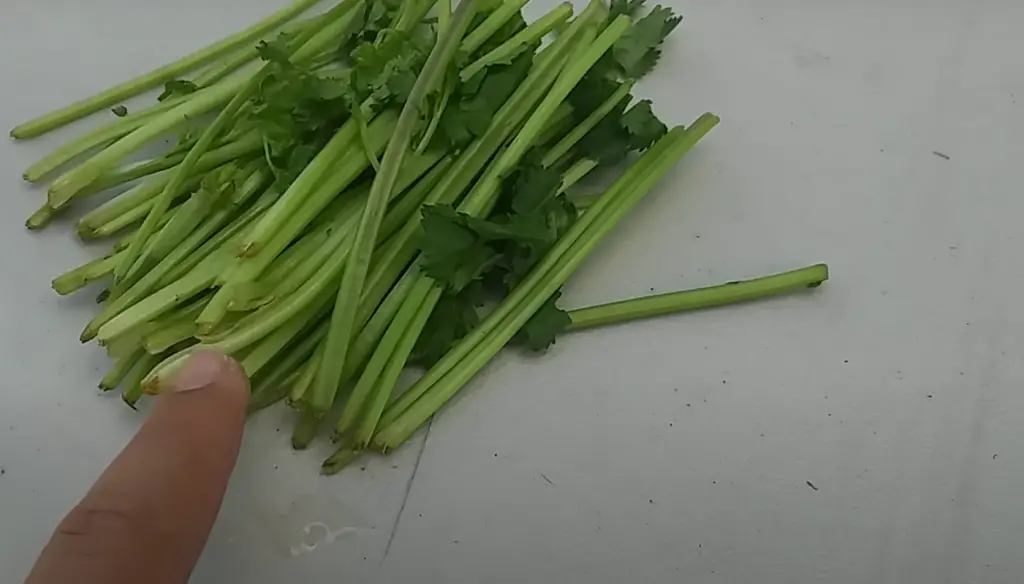
Second, you’ll save money in the long run since you won’t have to spend money on purchasing cilantro each time you need some for a recipe. Finally, growing your own cilantro is an enjoyable hobby that can give you a sense of satisfaction and pride when tending and harvesting your crop. With a few simple steps and tips on how to grow cilantro from cuttings, anyone can learn the basics of growing their own herbs!
Where to Find Cuttings for Planting?
If you’re looking to grow cilantro from cuttings, the first step is to find a healthy plant with good-sized stems. A local nursery or garden center is an excellent place to look for suitable specimens. If you’d rather buy online, many nurseries and gardening stores offer cilantro plants in pots as well as seedlings of different varieties. Make sure that the plant you choose doesn’t have any pests or diseases that could spread onto your future crop! [1]
Preparation for Planting the Cuttings
When preparing to grow cilantro from cuttings, it is important to get the best possible start. Proper soil preparation and cutting selection are both essential to ensure healthy growth and development.
Start by selecting a pot with decent drainage, as cilantro does not like soggy roots. A good soil mix should also contain organic material such as compost or manure, which will help the plant retain moisture and provide it with vital nutrients for its growth. Additionally, you may want to use a rooting hormone when planting the cuttings, which can increase your chances of success.
Dip the ends in rubbing alcohol or a dilute bleach solution to prevent any spreading of disease.Finally, when planting the cilantro cuttings, make sure to leave enough room between them and other plants (if you are planting multiple); this will give them all enough space to grow. Additionally, it’s important not to water the soil before sowing as this could cause root rot. When your cuttings have taken root and look healthy, only then should you begin watering your plant regularly.
Best Practices for Planting Cuttings
When planting cilantro cuttings, it’s important to choose healthy, robust plants. Avoid any that are wilted or discolored. Cuttings should be taken from the top of the plant where there is new growth and few if any flowers. The cutting should be around 4–6 inches long and include several leaves, but no blossoms. Use a sharp knife or pruning shears to ensure a clean cut.
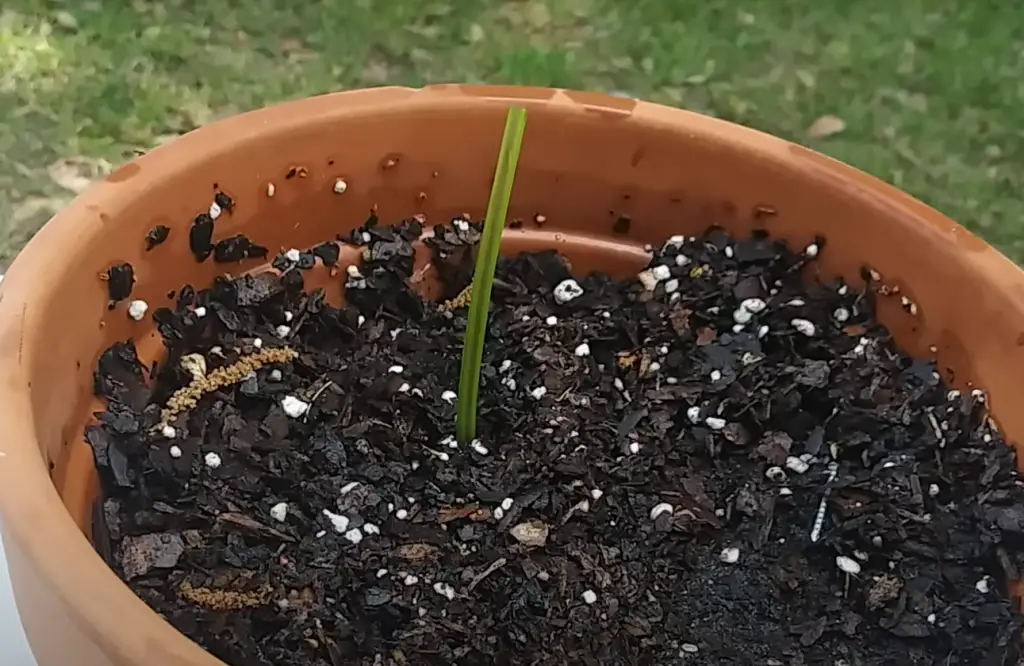
The soil for your cilantro cuttings should be well-drained and light, with plenty of organic matter such as compost. Make sure the soil is moist before you start planting.
Water gently and frequently to keep the soil moist, but not soggy. Place your cilantro cuttings in a warm, sunny spot with indirect light. After 4–6 weeks, you should be able to start harvesting your new cilantro plants! With regular care and maintenance, they should continue to produce leaves for several months. [2]
Harvesting Your Cilantro Cuttings
If you want to increase the amount of cilantro you have growing in your garden, one way to do this is by harvesting cuttings from existing plants. The best time to harvest cuttings for cilantro is when it’s just beginning to flower. You should use sharp pruning shears or scissors and snip off a stem that’s 4–6 inches long with several leaves attached at the top. Make sure there are no flowers on the cutting as these will not root properly. Once harvested, place the cutting in water until you’re ready to propagate them.
You can also collect seeds from mature cilantro plants and start new ones from scratch. To do this, wait until the plant has completely flowered and the flowers have turned into seed clusters. Once they’ve dried out, you can collect them and use them to sow new cilantro plants in your garden.
How to Know When it is Time to Harvest?
Harvesting cilantro is best done when the leaves are still small and young, as the flavor will be at its peak. Generally speaking, cilantro should be harvested when the plant is 6-8 inches tall.
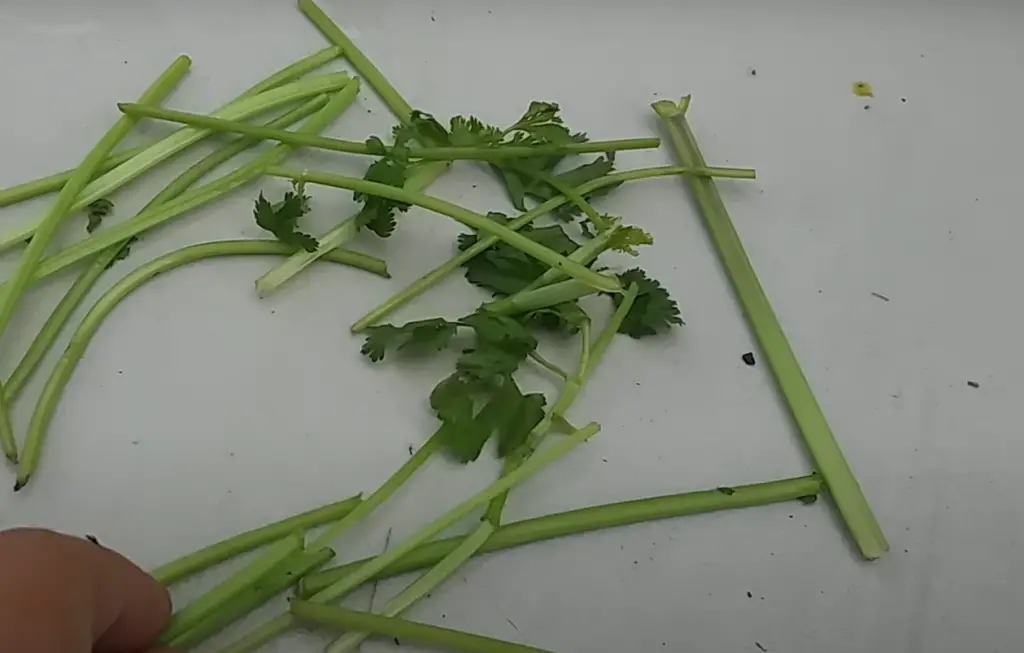
The stems can be cut at any point up to about 2/3 of their full length. If you wait too long to harvest, the leaves may become tough and bitter in flavor. To ensure a steady supply of cilantro all season long, consider harvesting on a regular basis by cutting off only a few stems with each pass. This will allow for new growth to resume while preserving an ongoing stock. As an added bonus, continuous harvesting encourages bushier, more compact plants which yield larger amounts of foliage over time.
Proper Handling of Cilantro After Harvest
Once you have successfully harvested your cilantro, it is important to take care of the herbs in order to maintain their freshness. Here are some tips for proper handling of cilantro after harvest:
- Keep the leaves as dry as possible; excess moisture will cause them to spoil more quickly.
- Place cilantro in a resealable plastic bag or container and store in the refrigerator’s vegetable drawer.
- If freezing, blanch the leaves first by dropping them into boiling water for 30 seconds before draining and cooling immediately. This helps preserve flavor and texture. Then place them in an airtight bag or container and freeze for up to 6 months. Freshly frozen cilantro can be used directly from the freezer—no need to thaw.
- Cilantro can also be dried; either air dry or use a dehydrator. Once completely dry, store in an airtight container away from light and moisture. Dried cilantro will keep for up to 6 months.
- To rehydrate, soak the leaves in hot water for 10 minutes before using them in recipes. [3]
Troubleshooting Common Problems with Growing Cilantro from Cuttings
Once you have successfully obtained cuttings from an existing plant, it is important to understand how to properly care for the cuttings to ensure they can grow into healthy plants. Here are some tips and common issues that may arise when growing cilantro from cuttings:
- Temperature: Make sure the temperature of your potting or garden soil stays between 65-75°F during the day and 55-60°F at night. Too much fluctuation in temperatures can cause the cutting to die. [4]
- Sunlight: Place the pot with your cilantro cutting in a bright spot with indirect sunlight (4-6 hours per day). Direct sunlight for extended periods of time will scorch new growth and can cause the cutting to die.
- Water: Keep the soil moist but not soggy. Too much water may drown your cutting, while too little will dry it out and kill it off.
- Pests & Diseases: Check for signs of pests or diseases such as aphids, thrips, fungus gnats, or root rot and treat accordingly with a natural insecticidal soap or fungicide product. [5]
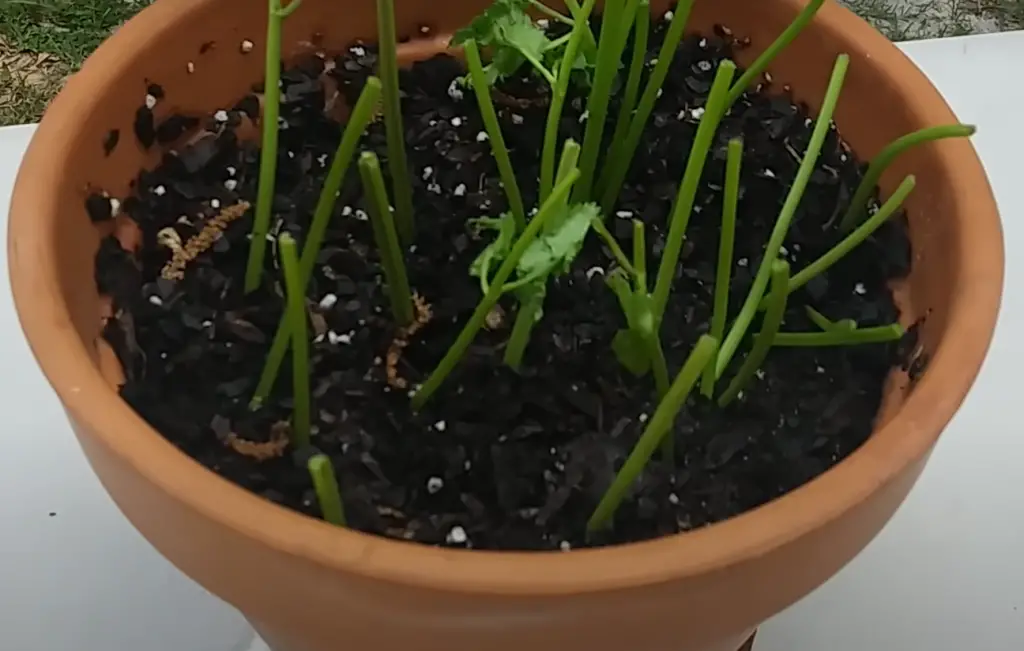
By following these tips and troubleshooting any issues that arise, you can successfully grow cilantro from cuttings!
FAQs
Is it Possible to Grow Cilantro From Cuttings?
Yes, it is possible to grow cilantro from cuttings. To do this, you need to take a cutting that has at least two nodes (a node is the point on the stem where leaves and roots emerge). Cut off the leafy parts of the stem and place them in water. Once they have rooted, transfer them into soil and keep them moist. With proper care, your cilantro should start growing within a few weeks.
What Kind of Soil Should I Use?
When growing cilantro from cuttings, it’s important to use a nutrient-rich and well-draining soil. Cilantro doesn’t like to sit in wet soil for long periods of time, so you’ll want to make sure your soil has good drainage. A mix of equal parts potting soil, compost, and perlite or vermiculite is ideal. If you can get your hands on some organic fertilizer, add a tablespoon into the mix before planting! This will give your cilantro an extra boost of nutrition as it grows. Be sure to water regularly and keep the soil moist but not saturated. With proper care, you should be able to enjoy fresh cilantro in no time!
How Long Does It Take For Cilantro Cuttings To Root?
Cilantro cuttings usually take 1–2 weeks to root and establish themselves in the soil. To speed up the process, you can use a rooting hormone on your cuttings before planting. This will help encourage strong, healthy roots to form quickly. Once rooted, cilantro should start producing leaves within 3-4 weeks. You can then harvest these leaves for cooking or drying as needed! With regular care and attention, you’ll be able to grow plenty of fresh cilantro from cuttings all season long! The next time you get a bunch of cilantro at the store, don’t throw away those stems – save them and give cilantro propagation a try!
What are Some Common Mistakes When Growing Cilantro From Cuttings?
One of the most common mistakes when growing cilantro from cuttings is not providing enough light or moisture. Cilantro needs a lot of sunlight to grow, so make sure it’s getting at least 6 hours per day. Additionally, keep the soil moist but not saturated as too much water can cause root rot. Finally, be sure to use a nutrient-rich and well-draining soil as cilantro doesn’t like sitting in wet soil for long periods of time.
What is the Best Time to Plant Cilantro Cuttings?
The best time to plant cilantro cuttings is in the early spring or late summer when temperatures are warm but not too hot. Early spring is ideal because it avoids any frosts, while late summer ensures you have enough warmth and light for the cutting to take root. For optimum growth, make sure your soil has been tilled and fertilized before planting the cuttings.
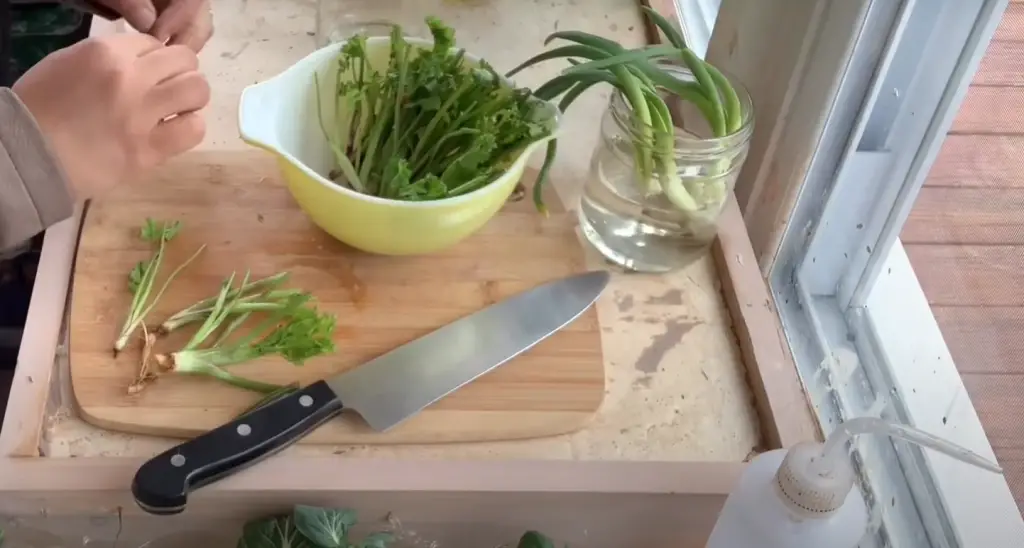
Plant cilantro cuttings about one inch deep in well-draining soil and water thoroughly after planting. Keep them moist during the first few weeks until they become established. When transplanting your cilantro cuttings, space them at least 8 inches apart as mature plants can quickly overcrowd a small area. With proper care and attention, you can successfully grow cilantro from cuttings and enjoy the fresh flavor of homegrown herbs right in your own backyard.
How Often Should You Water Cilantro Cuttings?
When growing cilantro from cuttings, it’s important to keep the soil evenly moist. If the soil dries out too much, your cilantro cuttings may wilt or die. To prevent this, water your cilantro cuttings two to three times a week or when the top inch of soil feels dry. Make sure not to over-water as that can lead to root rot. Additionally, if you live in an area with particularly hot summers, make sure to water your cilantro cuttings more frequently and add a layer of mulch around the plants to help retain moisture.
What are the Benefits of Growing Your Own Cilantro?
Growing your own cilantro has many benefits. For starters, homegrown cilantro is incredibly fresh and flavorful, while store-bought herbs can often be past their prime. Additionally, growing your own herbs can save you money in the long run as opposed to continually buying them from the grocery store. Lastly, home grown cilantro is free of chemicals or pesticides and you don’t have to worry about any hidden ingredients that might come with pre-packaged produce. With these factors in mind, it’s easy to see why so many people choose to grow their own cilantro from cuttings.
How Do I Harvest My Cilantro?
Cilantro is ready to harvest when the leaves are bright green and full. For the best flavor, pick your cilantro early in the morning before the sun has had a chance to heat up. To harvest, simply snip off each leaf at its base or cut off entire stems about an inch from the soil line. Make sure not to overharvest as this can deplete your plant’s energy reserves and stunt further growth. Once harvested, you can store fresh cilantro in a sealed container in your refrigerator for up to five days. Alternatively, you can freeze it for longer-term storage.
What Are Some Common Pests and Diseases That Can Affect Cilantro?
Unfortunately, cilantro can be affected by a variety of pests and diseases. Common pests that can affect cilantro include aphids, whiteflies and spider mites. To prevent infestation, make sure to regularly inspect your plants for signs of damage or discoloration. Additionally, you can use organic insecticides or natural solutions like neem oil to help deter any unwanted insects. As far as diseases go, cilantro is susceptible to root rot caused by overwatering or poorly draining soil. If you encounter this problem with your cilantro cuttings, try moving them to an area with better drainage and reduce watering frequency accordingly. With the right conditions and attentive care, you can easily grow lush and flavorful cilantro from cuttings in your own backyard!
Should I Fertilize the Soil Before Planting Cilantro Cuttings?
For the most part, you don’t need to fertilize the soil before planting cilantro cuttings. Cilantro is a fast-growing herb and does not require much by way of nutrients. However, if you want to ensure that your cilantro plants have the best chance of survival, then it is advisable to fertilize the soil before planting your cuttings. A general-purpose fertilizer such as 10-10-10 should be used at half strength and can be applied directly around each cutting or mixed into the soil prior to planting. If you choose to mix in fertilizer with the soil around each cutting, lightly rake up the surface after adding any fertilizer for better root penetration. It is important not to over-fertilize, as this can burn the cuttings and decrease your chances of successful planting. Lastly, keep in mind that cilantro does not need to be fertilized frequently; once every two months is enough for it to thrive.
Useful Video: How to grow cilantro from stems, no seeds needed!
Conclusion
In conclusion, while cilantro can be successfully grown from cuttings, it is not a guaranteed success and requires some skill and patience. The best way to ensure success is to use young, healthy stems with fresh green leaves, dip them in rooting hormone, then carefully place them into soil that has been moistened beforehand. Keep the soil moist but avoid over-watering. If everything is done correctly, you should see roots begin to form within 2–3 weeks. However, if there are any setbacks such as wilting or browning of the leaves or slow root growth, try adjusting your care routine accordingly to ensure successful cilantro propagation results. Good luck!
References:
- https://www.gardeningknowhow.com/edible/herbs/cilantro/propagate-cilantro.htm
- https://www.gardenerbasics.com/blog/growing-cilantro-from-cuttings
- https://www.backyardboss.net/how-to-grow-cilantro/
- https://www.homesandgardens.com/advice/how-to-grow-cilantro
- https://balconygardenweb.com/how-to-grow-cilantro-from-stem-cuttings/





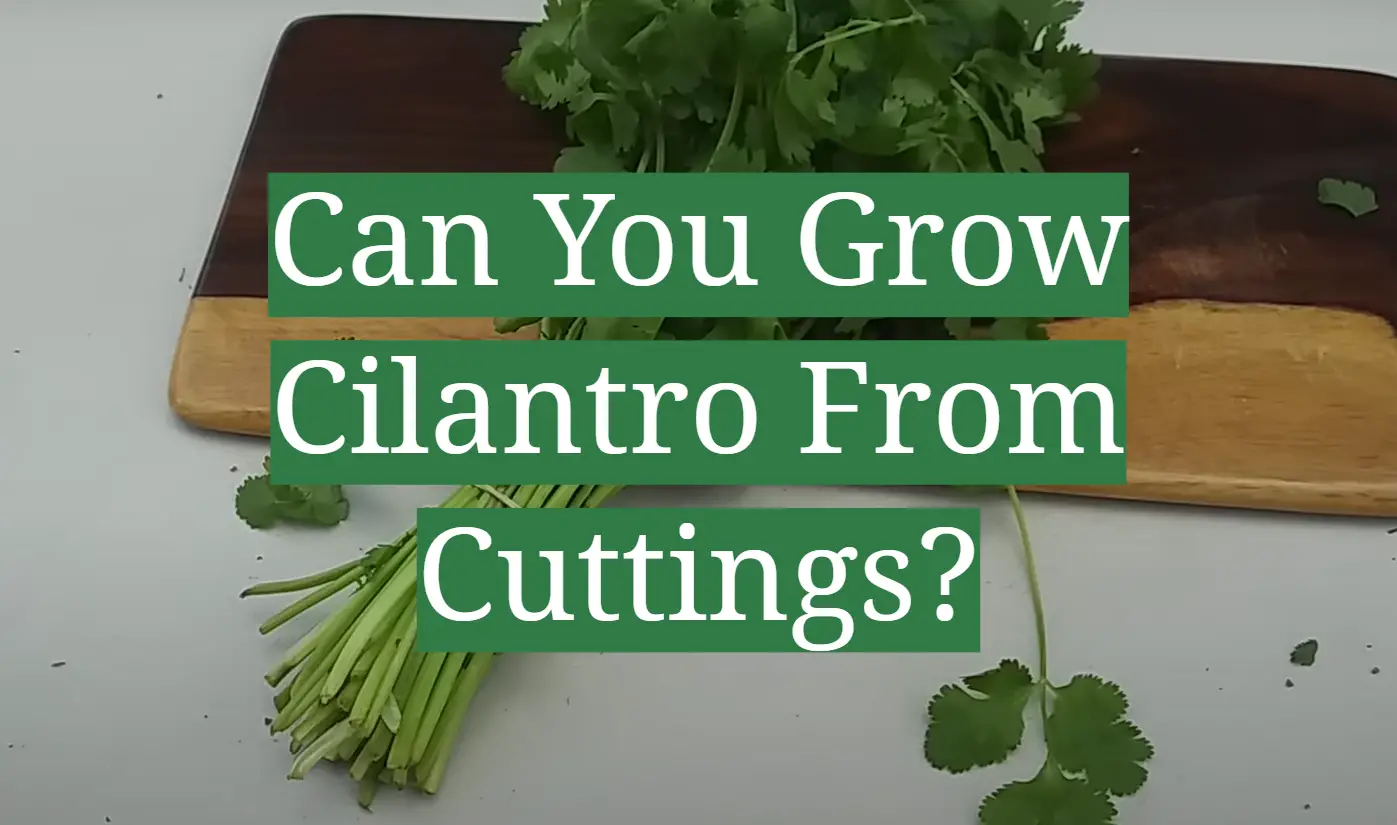




Leave a Reply
View Comments